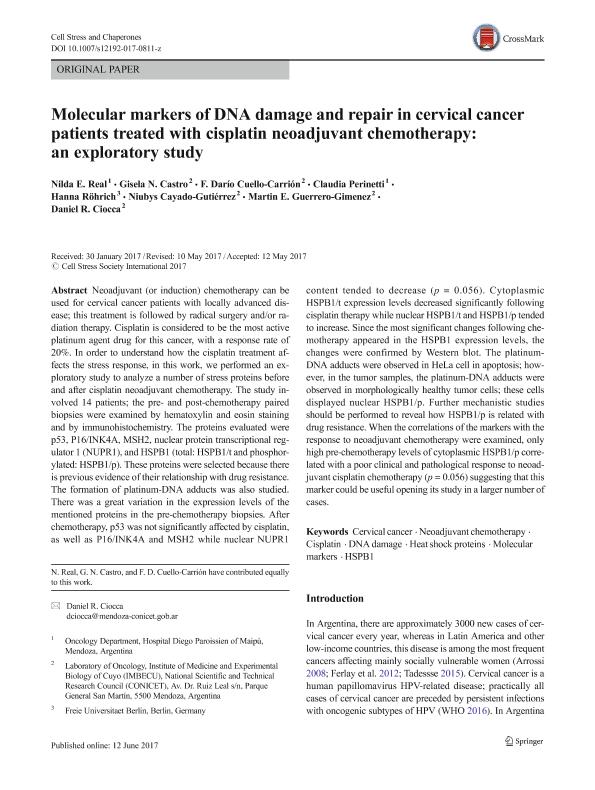Artículo
Molecular markers of DNA damage and repair in cervical cancer patients treated with cisplatin neoadjuvant chemotherapy: an exploratory study
Real, Nilda E.; Castro, Gisela Natalia ; Cuello Carrión, Fernando Darío
; Cuello Carrión, Fernando Darío ; Perinetti, Claudia; Röhrich, Hanna; Cayado Gutiérrez, Niubys de Los Milagros
; Perinetti, Claudia; Röhrich, Hanna; Cayado Gutiérrez, Niubys de Los Milagros ; Guerrero Gimenez, Martin Eduardo
; Guerrero Gimenez, Martin Eduardo ; Ciocca, Daniel Ramon
; Ciocca, Daniel Ramon
 ; Cuello Carrión, Fernando Darío
; Cuello Carrión, Fernando Darío ; Perinetti, Claudia; Röhrich, Hanna; Cayado Gutiérrez, Niubys de Los Milagros
; Perinetti, Claudia; Röhrich, Hanna; Cayado Gutiérrez, Niubys de Los Milagros ; Guerrero Gimenez, Martin Eduardo
; Guerrero Gimenez, Martin Eduardo ; Ciocca, Daniel Ramon
; Ciocca, Daniel Ramon
Fecha de publicación:
11/2017
Editorial:
Springer
Revista:
Cell Stress & Chaperones
ISSN:
1355-8145
Idioma:
Inglés
Tipo de recurso:
Artículo publicado
Clasificación temática:
Resumen
Neoadjuvant (or induction) chemotherapy can be used for cervical cancer patients with locally advanced disease; this treatment is followed by radical surgery and/or radiation therapy. Cisplatin is considered to be the most active platinum agent drug for this cancer, with a response rate of 20%. In order to understand how the cisplatin treatment affects the stress response, in this work, we performed an exploratory study to analyze a number of stress proteins before and after cisplatin neoadjuvant chemotherapy. The study involved 14 patients; the pre- and post-chemotherapy paired biopsies were examined by hematoxylin and eosin staining and by immunohistochemistry. The proteins evaluated were p53, P16/INK4A, MSH2, nuclear protein transcriptional regulator 1 (NUPR1), and HSPB1 (total: HSPB1/t and phosphorylated: HSPB1/p). These proteins were selected because there is previous evidence of their relationship with drug resistance. The formation of platinum-DNA adducts was also studied. There was a great variation in the expression levels of the mentioned proteins in the pre-chemotherapy biopsies. After chemotherapy, p53 was not significantly affected by cisplatin, as well as P16/INK4A and MSH2 while nuclear NUPR1 content tended to decrease (p = 0.056). Cytoplasmic HSPB1/t expression levels decreased significantly following cisplatin therapy while nuclear HSPB1/t and HSPB1/p tended to increase. Since the most significant changes following chemotherapy appeared in the HSPB1 expression levels, the changes were confirmed by Western blot. The platinum-DNA adducts were observed in HeLa cell in apoptosis; however, in the tumor samples, the platinum-DNA adducts were observed in morphologically healthy tumor cells; these cells displayed nuclear HSPB1/p. Further mechanistic studies should be performed to reveal how HSPB1/p is related with drug resistance. When the correlations of the markers with the response to neoadjuvant chemotherapy were examined, only high pre-chemotherapy levels of cytoplasmic HSPB1/p correlated with a poor clinical and pathological response to neoadjuvant cisplatin chemotherapy (p = 0.056) suggesting that this marker could be useful opening its study in a larger number of cases.
Archivos asociados
Licencia
Identificadores
Colecciones
Articulos(IMBECU)
Articulos de INST. DE MEDICINA Y BIO. EXP. DE CUYO
Articulos de INST. DE MEDICINA Y BIO. EXP. DE CUYO
Citación
Real, Nilda E.; Castro, Gisela Natalia; Cuello Carrión, Fernando Darío; Perinetti, Claudia; Röhrich, Hanna; et al.; Molecular markers of DNA damage and repair in cervical cancer patients treated with cisplatin neoadjuvant chemotherapy: an exploratory study; Springer; Cell Stress & Chaperones; 22; 6; 11-2017; 811-822
Compartir
Altmétricas



